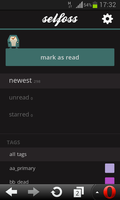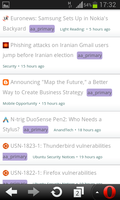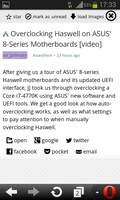Google will terminate their RSS Reader service by the end of the month and I guess I am not the only one looking for alternative solutions to get that daily dose of news from blogs and news web sites on the way to and from work. While it obviously means work it's also an opportunity to 'in-source' another service to further reduce my dependency on cloud service providers.
Selfoss – The Central RSS Server
There are a couple of self-hostable RSS retrieval solutions with a server component that queries RSS feeds from a central place and then allows access to the content from smartphones, tablets and PCs while keeping track of what has already been read. The one I've been taking a closer look at is Selfoss as it's open source, light weight and requires little on the server side. Coupled with a Raspberry Pi it could be an inexpensive solution not only as far as the cost for hardware is concerned but also operating cost wise as the power requirements of a Raspberry Pi amounts to around 6 Euros a year.
Installation Process Overiew
I have to admit I had some difficulties getting Selfoss installed. The instructions suggest that it's a straight forward process. In practice, however, I struggled to get it working with the Apache and PHP installation I already have on a Raspberry Pi for my Owncloud server. In the end I gave up and instead opted to install it on a clean Raspian image. That worked pretty well and I'll have another post shortly describing the details. Combined with https only access and http layer username and password identification I can access the service over the Internet in a secure way.
Features
So far I am pretty happy with Selfoss. While I struggled to get my Google Reader OPML export file imported into Selfoss in version 2.4, it worked flawlessly with the current v2.7. Most of the time I read my RSS feeds on the mobile and the mobile browser optimized pages give me easy access to unread posts, to all posts ordered by date and to all posts of a particular site. In the overview, only the headlines of each post is shown and clicking on it reveals the full text. While posts can be individually marked as read I prefer the button that let's me mark all unread posts as read as this is more convenient for me as I usually don't want to read all new posts. Also, there's a link in each post that opens a new browser page to the post on the original website. Perfect, that's pretty much all I need.
Pictures
And here are some pictures for you to get an impression before the second part of the post contains the installation instructions specifically for a Raspberry Pi running on Raspian.



Hi Martin, one question – why did you not consider feedly which is being widely touted as an easy to use google reader replacement?
Hi Bin,
I wanted to host my own RSS aggregator at home to become independent from a particular service provider. So while it might have been easier to migrate to Feedly I would have gone from one service company to another, which is not what I had in mind.
Cheers,
Martin